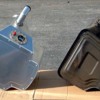Mark
Mark
Replies sorted oldest to newest
I've been looking at fuel cells as well, but I'm having trouble finding something off the shelf that works for me, so I am considering having a tank made and was wondering if anyone has used www.fueltankparts.com? They look to be very reasonably priced.
Thanks!
I need a fuel cell that has a bladder and foam in order to comply with tech requirements at various open road races. I did not see those items listed with the company you listed.



I'll only need the length. I will try to get the largest rectangular tank that will fit within your dimensions. I'm not trying to go for the max configuration.
Thanks for providing another approach. I know that ultimately I will need more than 20 gallons for open road racing.
Sorry, didn't know your intent and needs. I'm just looking for a suitable tank for recreational driving, so I have a lot more leeway.
Good luck!
Paul
Paul
Attachments
quote:Originally posted by David_Nunn:
The Triworks tank was designed, and the pieces laser cut, by Norberg Design. Triworks then welded the pieces together.
Norberg Design (@norbergdesign on Instagram) should be able to incorporate the addition of a bladder into the design then since the inner support spine will need to be deleted or modified. You will also need to use a different fuel sender design to work with the bladder such as one made by Centroid. Their Fuel Level Senders work by measuring capacitance so there are no moving parts involved. Electronics in the head convert this measured capacitance to the programmed output of ohms or volts. It was a subject of a previous topic on fuel sending units on this forum.
Attachments
quote:Originally posted by LIV1S:...You will also need to use a different fuel sender design to work with the bladder...
Sorry guys, but I got a dumb question.
does a fuel cell bladder just line the tank, thus holding fuel and air, allowing the fuel to settle to the bottom of the tank as used
Or
Does the bladder expand and contract to hold only fuel and thus keeping the fuel at the same "level" as it is used
quote:Originally posted by JFB #05177:quote:Originally posted by LIV1S:...You will also need to use a different fuel sender design to work with the bladder...
Sorry guys, but I got a dumb question.
does a fuel cell bladder just line the tank, thus holding fuel and air, allowing the fuel to settle to the bottom of the tank as used
Or
Does the bladder expand and contract to hold only fuel and thus keeping the fuel at the same "level" as it is used
Hello JFB; You were very helpful in the generous giving of your time, so I'm returning the favor.
Here you go,
https://www.youtube.com/watch?v=GwXuqWvCrwU
Fuel Safe have manufactured Pantera fuel cells to roughly the same dimensions as a Pantera gas tank; volume is about 1.5 gallons less due to slight dimensional changes and the foam etc. Dennis Quella has the rights to the design and order has to go through him, cost was about $2500
Julian
Attachments
Hello friends, maybe a silly question - but I have to do also a new fuel tank and the shipping to europe is verry expensive , also I want to fill it with foam . Is it possible to get a cad file ? Thanks
Peter
If no CAD file readily available, then consider getting your existing tank 3D scanned and converted to CAD, the cost is relatively minor these days.
I have a fuel cell (unused) that will be going up for sale as soon as I can dig it out for photos.
I had a tank build to my specification in the UK by Alloy Racing Fabrications. The tank is about 65-70 liters, sits in the original position in the car and is foam filled. It conforms with FIA app. K class H1 which requires foam filled tanks. It is smaller than the original, but I'll only use the car for shorter sprint races. Price was about euro 900 incl. shipping to Denmark.
I do not have a CAD, but made af drawing in Word grids, which worked fine. They did a fantastic job exact to my measurements.
Attachments
Push, that's a nice looking tank. The OP didn't specify what year his Pantera was. Note that on pushbuttons, the upper part of stock gas tanks were different shapes than in '71-up production Panteras. For instance, Ted Mitchell found that the stock alloy tank from his '71 pushbutton would not fit in his '74 since the upper left chassis subframes were different. The right side subframe was not checked but was likely different as well. To make the early tank fit the later car, Ted had to cut the whole upper section off, modify it to fit, then reweld the parts. Quite a bit of work for a 6 lb weight loss with about the same 21 gal fuel volume. This was subject of a POCA Newsletter article in April 2011.
The early and later Illustrated Parts Manuals shows different part numbers for the various formed steel beams that make up the rear frames, for different years. The long tank retaining strap was also a different length. So your dimensions may be of limited value to most other owners.








![IMG_0637[1] IMG_0637[1]](https://pantera.infopop.cc/fileSendAction/fcType/0/fcOid/1598208419964080/filePointer/16806793565052784/fodoid/16806793565052780/imageType/SQUARE_THUMBNAIL/inlineImage/true/IMG_0637%5B1%5D.jpg)
![IMG_0638[1] IMG_0638[1]](https://pantera.infopop.cc/fileSendAction/fcType/0/fcOid/1598208419964080/filePointer/16806793565052785/fodoid/16806793565052781/imageType/SQUARE_THUMBNAIL/inlineImage/true/IMG_0638%5B1%5D.jpg)